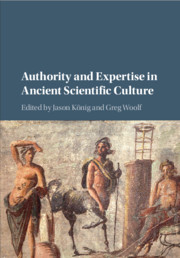Book contents
- Authority and Expertise in Ancient Scientific Culture
- Authority and Expertise in Ancient Scientific Culture
- Copyright page
- Contents
- Contributors
- Preface
- Abbreviations
- 1 Introduction: Self-Assertion and Its Alternatives in Ancient Scientific and Technical Writing
- 2 Philosophical Authority in the Imperial Period
- 3 Philosophical Authority in the Younger Seneca
- 4 Iurisperiti: ‘Men Skilled in Law’
- 5 Making and Defending Claims to Authority in Vitruvius’ De architectura
- 6 Fragile Expertise and the Authority of the Past: The ‘Roman Art of War’
- 7 Conflicting Models of Authority and Expertise in Frontinus’ Strategemata
- 8 The Authority of Writing in Varro's De re rustica
- 9 The Limits of Enquiry in Imperial Greek Didactic Poetry
- 10 Expertise, ‘Character’ and the ‘Authority Effect’ in the Early Roman History of Dionysius of Halicarnassus
- 11 The Authority of Galen's Witnesses
- 12 Anatomy and Aporia in Galen's On the Construction of Fetuses
- 13 Varro the Roman Cynic: The Destruction of Religious Authority in the Antiquitates rerum divinarum
- 14 Signs, Seers and Senators: Divinatory Expertise in Cicero and Nigidius Figulus
- 15 The Public Face of Expertise: Utility, Zeal and Collaboration in Ptolemy's Syntaxis
- 16 The Authority of Mathematical Expertise and the Question of Ancient Writing More Geometrico
- 17 Authority and Expertise: Some Cross-Cultural Comparisons
- Bibliography
- Index
- References
Bibliography
Published online by Cambridge University Press: 26 January 2017
- Authority and Expertise in Ancient Scientific Culture
- Authority and Expertise in Ancient Scientific Culture
- Copyright page
- Contents
- Contributors
- Preface
- Abbreviations
- 1 Introduction: Self-Assertion and Its Alternatives in Ancient Scientific and Technical Writing
- 2 Philosophical Authority in the Imperial Period
- 3 Philosophical Authority in the Younger Seneca
- 4 Iurisperiti: ‘Men Skilled in Law’
- 5 Making and Defending Claims to Authority in Vitruvius’ De architectura
- 6 Fragile Expertise and the Authority of the Past: The ‘Roman Art of War’
- 7 Conflicting Models of Authority and Expertise in Frontinus’ Strategemata
- 8 The Authority of Writing in Varro's De re rustica
- 9 The Limits of Enquiry in Imperial Greek Didactic Poetry
- 10 Expertise, ‘Character’ and the ‘Authority Effect’ in the Early Roman History of Dionysius of Halicarnassus
- 11 The Authority of Galen's Witnesses
- 12 Anatomy and Aporia in Galen's On the Construction of Fetuses
- 13 Varro the Roman Cynic: The Destruction of Religious Authority in the Antiquitates rerum divinarum
- 14 Signs, Seers and Senators: Divinatory Expertise in Cicero and Nigidius Figulus
- 15 The Public Face of Expertise: Utility, Zeal and Collaboration in Ptolemy's Syntaxis
- 16 The Authority of Mathematical Expertise and the Question of Ancient Writing More Geometrico
- 17 Authority and Expertise: Some Cross-Cultural Comparisons
- Bibliography
- Index
- References
- Type
- Chapter
- Information
- Authority and Expertise in Ancient Scientific Culture , pp. 424 - 462Publisher: Cambridge University PressPrint publication year: 2017



